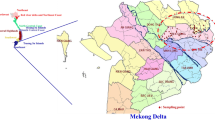Abstract
One of the most severe issues for water supply in Bangladesh is high arsenic concentrations. Widespread implementation of tubewells was determined to be highly problematic due to arsenic contamination in the groundwater. For substantial areas in Bangladesh, groundwater cannot be utilized for water supply without treatment to reduce arsenic levels. Thus, calculations for the incremental excess lifetime cancer risk are used to demonstrate that indeed, seeing elevated arsenicosis must be expected. By observing the correlations between arsenic and iron and the prevalence of arsenicosis patients, the relationships among the concentrations of arsenic and iron, and the percentage of contaminated wells are significant for determining the prevalence of arsenicosis. The results declare that high arsenic concentrations and high percentages of contaminated wells, as well as the lower iron concentrations, lead to a higher prevalence of arsenicosis patients. It demonstrates the validity of the risk calculation procedure and single arsenic concentrations cannot provide good prediction of arsenicosis risk. When the concentration of arsenic and iron are both high, the ratio of arsenic/iron will decrease, and the arsenicosis rates will lessen, as well. The findings indicate that co-precipitation of iron and arsenic can remove some of the arsenic before the groundwater is consumed.



Similar content being viewed by others
References
Ahmed KM, Ravenscroft P (2009) Review of data on the status of arsenic pollution and arsenic mitigation in Bangladesh for revision of the implementation plan for arsenic mitigation 2009. WSP-WB World Bank Dhaka Office, Agargaon, p 1209
Bangladesh Board of Investment (2011) Bangladesh at a glance. http://boi.gov.bd. Accessed 13 March 2011)
Brennan R, Mcbean E (2011a) A performance assessment of arsenic-iron removal plants in the Manikganj District of Bangladesh. J Water Health 9:317–329
Brennan R, McBean E (2011b) The role of orthophosphate and dissolved oxygen in the performance of arsenic-iron removal plants in Bangladesh. J Environ Sci Health A 46(4):426–435
British Geological Survey (2000) Water quality fact sheet: arsenic. BGS, Edinburgh
Deviney FA Jr, Brown DE, Rice KC (2012) Evaluation of bayesian estimation of a hidden continuous-time Markov chain model with application to threshold violation in water-quality indicators. J Environ Inform 19(2):70–78
Epa US (2005) Guidelines for carcinogen risk assessment risk assessment forum. U.S. Environmental Protection Agency, Washington, DC
Faisal H, Bellie S (2006) Spatial pattern of arsenic contamination in shallow wells of Bangladesh: regional geology and nonlinear dynamics. Stoch Environ Res Risk Assess 20:66–76
Gao HF, Bai JH, Xiao R, Liu PP, Jiang W, Wang JJ (2012) Levels, sources and risk assessment of trace elements in wetland soils of a typical shallow freshwater lake, China. Stoch Environ Res Risk Assess. doi:10.1007/s00477-012-0587-8
Guo P, Huang GH (2009) Two-stage fuzzy chance-constrained programming: application to water resources management under dual uncertainties. Stoch Environ Res Risk Assess 23:349–359
Huang Y, Li YP, Chen X, Bao AM, Ma YG (2012) A multistage simulation-based optimization model for water resources management in Tarim River Basin, China. Stoch Environ Res Risk Assess. doi:10.1007/s00477-012-0585-x
JICA, AAN (2004) Integrated approach for mitigation of as contamination of drinking water in Bangladesh. An arsenic mitigation project on Sharsha Upazila, Jesssore. Final report, November 2004. Japan International Cooperation Agency, Asia Arsenic Network, Dhaka
Li YP, Huang GH (2009) Two-stage planning for sustainable water quality management under uncertainty. J Environ Manag 90(8):2402–2413
Li YP, Huang GH (2011) Planning agricultural water resources system associated with fuzzy and random features. J Am Water Resour Assoc 47(4):841–860
Liu Z, Tong STY (2011) Using HSPF to model the hydrologic and water quality impacts of riparian land-use change in a small watershed. J Environ Inform 17(1):1–14
Neumann R, Ashfaque K, Badruzzaman ABM, Ali MA, Shoemaker J, Harvey C (2010) Anthropogenic influences on groundwater arsenic concentrations in Bangladesh. Nat Geosci 3(1):46–52
NGOs Arsenic Information and Support Unit (NAISU) (2003) Arsenic 2002: an overview of arsenic issues and mitigation initiatives in Bangladesh. NGO Forum for Drinking Water Supply and Sanitation, and Water Aid, Bagerhat
Safiuddin Md, Karim Md (2001) Groundwater arsenic contamination in Bangladesh: causes, effects, and remediation. In: Proceedings of the first institution of engineers, Bangladesh (IEB). International Conference and 7th Annual Paper Meet, Chittagong
Sambu S, Wilson R (2008) Arsenic in food and water: a brief history. Technol Ind Health 24(4):217–226
Smedley PL, Kinniburgh DG (2001) Source and behaviour of arsenic in natural waters, Chap. 1. In: United Nations synthesis report on arsenic in drinking water, p 1–61. WHO, Geneva
UNICEF (2008) Arsenic mitigation in Bangladesh. UNICEF, New York
U.S EPA (U.S. Environmental Protection Agency) (1996) OPPTS harmonized test guidelines. http://www.epa.gov/opptsfrs/publications/OPPTS_Harmonized/870_Health_Effects_Test_Guidelines/. Accessed 16 Aug 1996
Van Geen A, Zheng Y, Versteeg R, Stute M, Horneman A, Dhar R, Steckler M, Gelman A, Small C, Ahsan H, Graziaon J, Hussain I, Ahmed K (2003) Spatial variability of arsenic in 6000 tubewells in a 25 km2 area of Bangladesh. Water Resour Res 39(5):1140–1156
World Health Organization (2000) Researchers warn of impending disaster from mass arsenic poisoning. WHO, Geneva
World Health Organization (2008) An interview with Mahmuder Rahman: Bangladesh’s Arsenic agony. Bull World Health Organ 86(1):11–12
Zhang YY, Xia J, Shao QX, Zhai XY (2011) Water quantity and quality simulation by improved SWAT in highly regulated Huai River Basin of China. Stoch Environ Res Risk Assess. doi:10.1007/s00477-011-0546-9
Zheng C, Yang W, Yang ZF (2011) Strategies for managing environmental flows based on the spatial distribution of water quality: a case study of Baiyangdian Lake, China. J Environ Inform 18(2):84–90
Acknowledgments
The assistance of Shafiul Ahmed, Ryan Brennan, and Katy Falk in the assembly and calculation procedures is gratefully acknowledged. Research funding from the Canada Research Chairs program of Canada was instrumental in completing this research. The author is very grateful to the editors and the anonymous reviewers for their insightful comments and suggestions.
Author information
Authors and Affiliations
Corresponding author
Rights and permissions
About this article
Cite this article
McBean, E.A. Risk characterization for arsenic-impacted water sources, including ground-truthing. Stoch Environ Res Risk Assess 27, 705–711 (2013). https://doi.org/10.1007/s00477-012-0633-6
Published:
Issue Date:
DOI: https://doi.org/10.1007/s00477-012-0633-6




